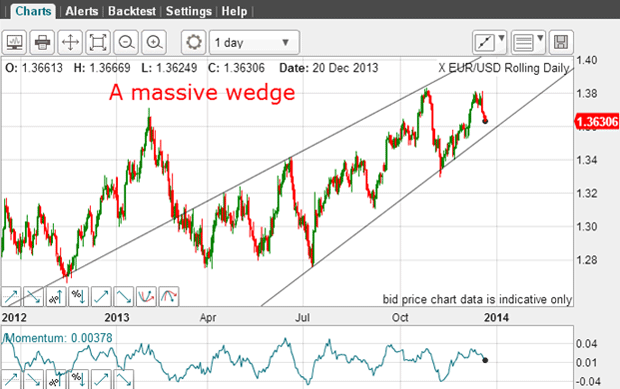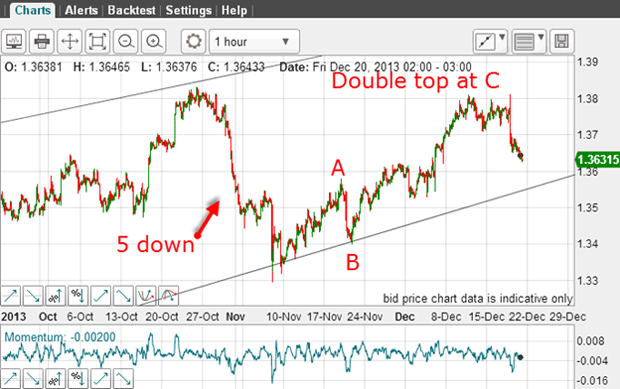The US dollar is back in rally mode
The much anticipated taper has sent the dollar soaring. John C Burford examines the charts to see if the rally has further to go.
When the Fed decided to gradually taper its bond-buying programme on Wednesday, stock markets took it as a green flag to race even further ahead. But it was the reaction of the less-reported US dollar that took my eye.
Incidentally, the overwhelming stance of the pundits towards the Fed's taper news was super-bullish. Here is a selection of instant reactions from seekingalpha.com on Thursday: "Fed drops the green flag and bulls are off to the races", "Putting 2014 in perspective", "Lo, a market e'er booming", "Taper refreshes bullish outlook", "A taper to new highs", "Don't fight the Fed".
Hoping for a big finish
And that starkly illustrates the principle that the markets make the news. How many bulls will now be even more emboldened in their positions after reading such material and the market's instant reaction to the Fed news? Many will go back into the market and load up on even more equities.
MoneyWeek
Subscribe to MoneyWeek today and get your first six magazine issues absolutely FREE

Sign up to Money Morning
Don't miss the latest investment and personal finances news, market analysis, plus money-saving tips with our free twice-daily newsletter
Don't miss the latest investment and personal finances news, market analysis, plus money-saving tips with our free twice-daily newsletter
Dollar dives, then reverses
EUR/USD was challenging the 1.38 level
But the euro is only one component of the Dollar Index (albeit the largest part). Here is the hourly chart of the Dollar Index which clearly shows the huge reversal on Wednesday:

Note the plunge at 7pm UK time when the Fed's news hit the world. This took out a mass of sell-stops placed there by hopeful longs who believed the 80 level was going to be the low. This is yet another cruel aspect of markets, because when that selling dried up, there was a complete reversal - with buyers in the ascendancy.
The vigorous rally then knocked out all the buy-stops in the 80.40 area, in a textbook demonstration of a whipsaw.
Those longs that had been stopped out must be wondering if the world was against them. The market turned in their favour, but they made no money.
What a wonderful lesson in how to handle the markets psychologically.
Many traders would give up in disgust after such a setback, but a trader who approaches the markets with a cool and calculating detachment would likely see the reversal, quickly size up the situation and jump back in.
I like whipsaws, because they give me an opportunity to observe market reaction following a move to a new low. If, as in this case, the market does not move decisively lower, but instead reverses, the odds are good that the market has made a major turn and it is now safe' to jump on board the new trend.
Market hits double top
Let's see what the market has done since then. (After all, the EUR/USD cross is the preferred market to trade, rather than the Dollar Index). Here is the daily chart:

The reversal from the 1.38 level was swift and sets up the probability that the market has made a double top at the 1.38 level. Here is the hourly chart:

From the first top in October, there is a clear 5-wave down, indicating the trend has changed to down. From the 1.33 low, the market has rallied in three clearA-B-C waves with the C wave being especially strong.
To qualify as a genuine double top, the tops need to be at least six weeks apart, and this one does conform.
The big test of the new trend will come if the market can decline to test the lower wedge line in the 1.3580 region, which is only around 50 pips away as I write.
But so far, the 1.38 level does remain a massive barrier - and if the Fed can't overcome it, then what can? As they say, don't fight the Fed.
This'll be my last market commentary post of the year. I'd like to wish you a happy Christmas, and I look forward to a great year of trading in 2014!
Get the latest financial news, insights and expert analysis from our award-winning MoneyWeek team, to help you understand what really matters when it comes to your finances.
John is is a British-born lapsed PhD physicist, who previously worked for Nasa on the Mars exploration team. He is a former commodity trading advisor with the US Commodities Futures Trading Commission, and worked in a boutique futures house in California in the 1980s.
He was a partner in one of the first futures newsletter advisory services, based in Washington DC, specialising in pork bellies and currencies. John is primarily a chart-reading trader, having cut his trading teeth in the days before PCs.
As well as his work in the financial world, he has launched, run and sold several 'real' businesses producing 'real' products.
-
 Leaving it too late to gift inheritances costs some of Britain’s wealthiest families £3m each
Leaving it too late to gift inheritances costs some of Britain’s wealthiest families £3m eachEven average Brits are being landed with huge and unexpected inheritance tax bills because of a little understood rule around gifting, new figures show
-
 The best and worst performing UK stocks of 2025 as FTSE 100 approaches record year
The best and worst performing UK stocks of 2025 as FTSE 100 approaches record yearThe blue-chip index is heading for another top year despite investors steering clear of UK equity funds